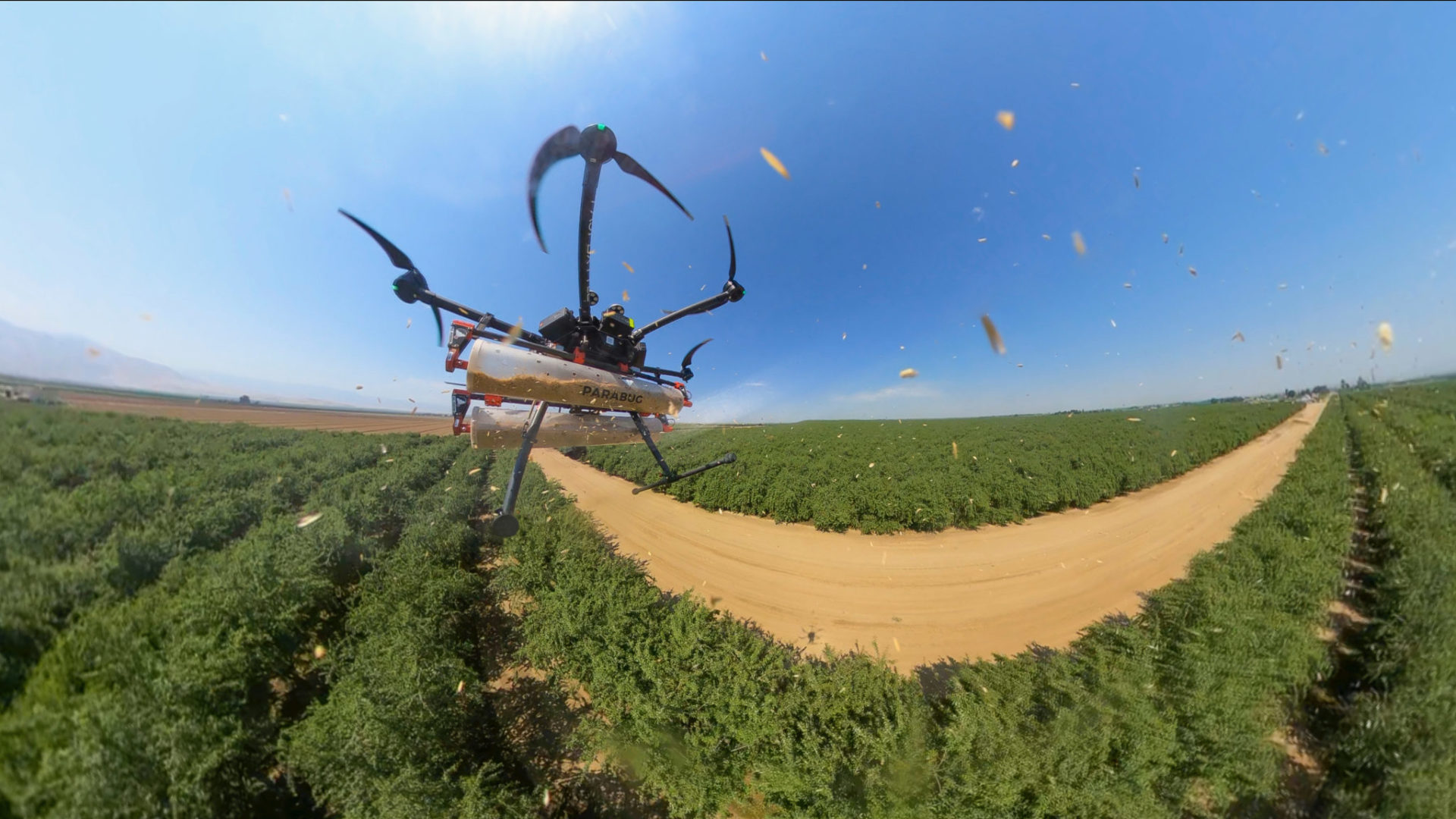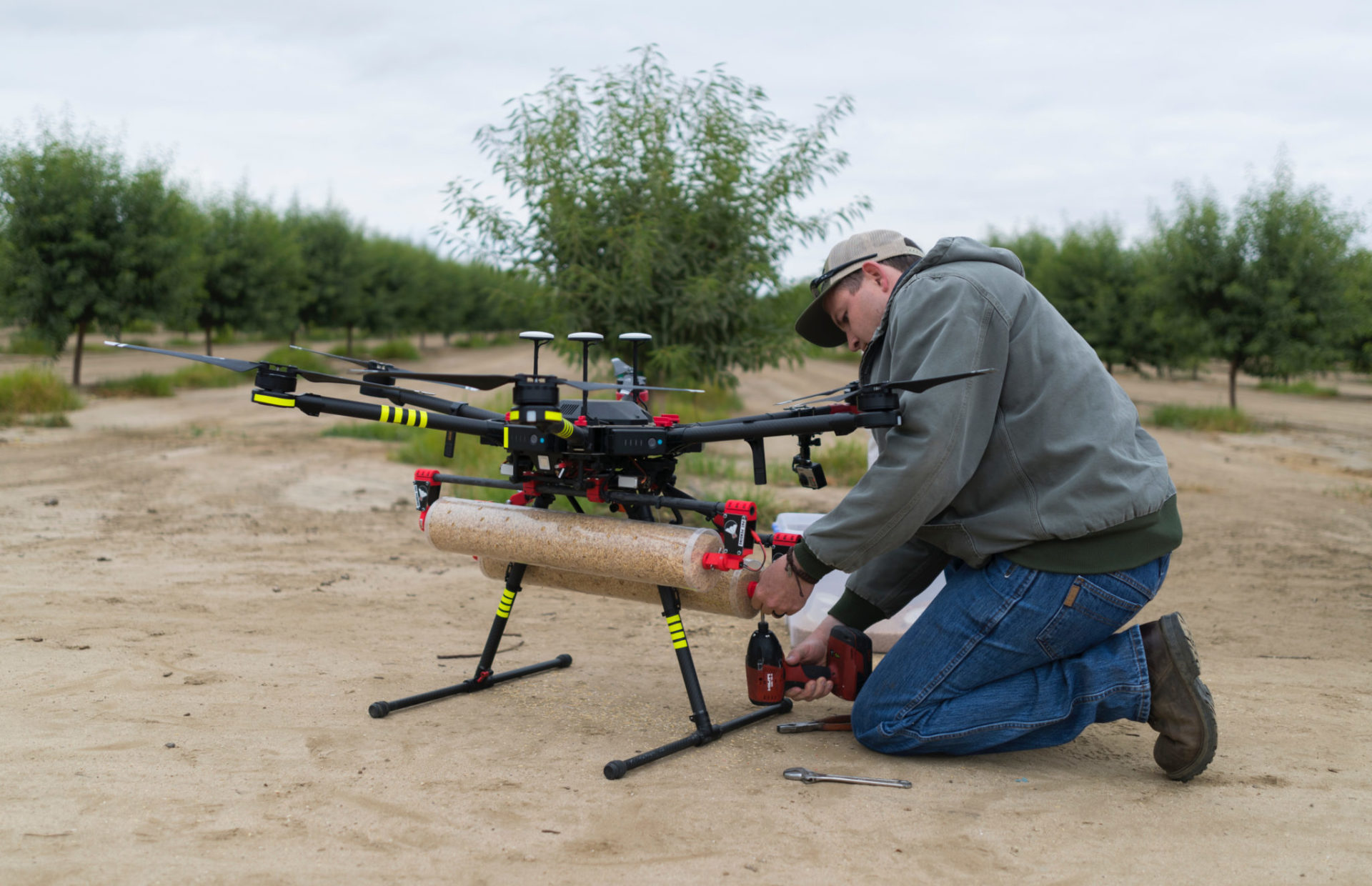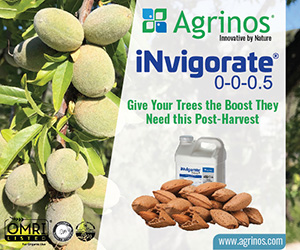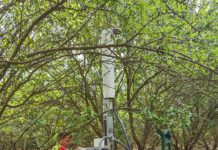
For Kern County farmer Kent Stenderup, biocontrol is the way to go when it comes to controlling spider mites in his family’s almond orchard. And applying the beneficial mites with a drone is the obvious choice.
The biocontrol strategy fits with the Almond Board of California’s goal of increasing environmentally friendly pest management in California orchards and adheres to the farm’s commitment to integrated pest management (IPM). “We think that over a few years, we can build up the beneficial insect population with this biocontrol product and get a handle on our mite pressure without having to spray for it,” Stenderup said.

Stenderup Ag Partners, which produces organic juice grapes in addition to conventional almonds, had applied beneficial mites to grapes by hand until this past season, when they began using Parabug Solutions to apply beneficials to its grapes and its almonds. Drone applications, he said, are a step up.
Using drones to apply beneficials is a relatively new phenomenon that has been introduced to California almond growers only in the past few years. The idea struck Chandler Bennett, founder of Parabug, while taking an IPM class at Cal Poly, where he obtained a Bachelor of Science in bio resource and ag engineering.
“When I came up with the idea, I looked around to see if anyone was applying these biocontrols mechanically, and I couldn’t find anything,” Bennett said. “So, I started this as a side project in college.”
After graduating in 2014, Bennett went to work for a strawberry producer who applied predatory mites by hand to control voracious mites. “That is when it really hit home how much labor it took to do that,” he said. “So, then I really dove into it. I went through a few prototypes and came across what I think is the best means of applying biocontrols mechanically.”
Bennett designed the Parabug system specifically for predatory mites, but he said it works for a variety of biocontrols. “At this point, we’ve applied pretty much every commercially reared biocontrol that I can think of through Parabug, whether it be predatory mites, parasitoids or others,” he said.

Steady Growth
Parabug and its main competitor in the Central Valley, UAV-IQ, have grown their businesses significantly in recent years. “There are a couple of drivers that are driving the adoption of drones,” said Andreas Neuman, co-founder and CEO of UAV-IQ. “Labor, both the costs and the availability of it, is one of them, and so is quality.
“There are clear advantages of using machines over people,” Neuman added. “Our equipment is specifically calibrated for a certain release rate per acre. If you are a human doing this for five or six hours, is your one-hundredth acre going to be as uniform as your first acre? For a drone, the answer is yes. For a human, the answer is usually no.”
Also, Neuman said, there are times when it is difficult to get a tractor into a field. With drones, that isn’t an issue. And, he said, in almonds, there isn’t a good substitute. “How else are you going to get the beneficials to the top of a tree that is over ten-feet tall?”
Biocontrols have long been used in California agriculture, particularly in strawberry production, but also, less prominently, in tree nuts. “People would hire crews that would take hundreds of bottles of insects and pour out small amounts onto the plants, whether it be trees or berries or whatever,” Bennett said. “Then newer, more selective chemistries came out, and labor got expensive, and people kind of moved away from biocontrol.
“Now that we have brought down the cost of applying them, growers are revisiting the idea of using biocontrol,” he said.
Parabug and UAV-IQ routinely apply two types of predatory mites to almonds. One, the Neoseiulus californicus, is relatively inexpensive, more widely reared, and more readily available. It, however, is a little more susceptible to temperature and humidity factors than the Galendromus occidentalis, or the western predatory mite.
“The occidentalis does a really great job in the Central Valley,” Bennett said. “It is adapted for lower humidity and higher temperatures, but it is a little more pricey, and it currently is reared by only one insectary that we are aware of (Biotactics), so it isn’t as widely available.”
The californicus will slow down and not perform as well above 100 degrees Fahrenheit, Bennett said, whereas the occidentalis can handle temperatures of 110 degrees and higher. “And it can handle lower humidity,” he said, “as low as 20 to 30 percent.”
Proper Application is Key
Andrew Maltby, president of Biotactics, said that in addition to selecting the right beneficial for a particular need, applying them properly is critical to optimizing performance. To that end, he likes to be on hand at application sites to ensure his predator mites are being released properly.
“We have a novel rearing process and I know the mites that come out of my farm are the highest quality available in the world,” Maltby said. “But if they aren’t put on the plant properly, then you aren’t going to get the performance that we are promoting. So, I do my best to facilitate that for the end user.”
Maltby said is also is important for growers to give Biotactics at least two weeks lead time to get orders ready.
The percentage of conventional orchards using biocontrols is small, according to sources. Kent Daane, a UC Cooperative Extension IPM specialist based at the Kearney Ag Center in Parlier, estimated that they are being used on about five percent of California’s almond acres, but he said that could increase significantly in the years ahead.
“Growers are always adopting more sustainable practices, and, if it works, there is definitely a market for it,” Daane said. “I think people can look for a realistic 25 to 50 percent use in terms of almond growers releasing beneficials if the practice can be as cost effective as pesticides.”
Daane added that growers looking to adopt use of biocontrols need to look at their entire pest-management system. “If you are releasing beneficials for mites but spraying with a broad-spectrum material for the navel orangeworm, then that might negate the money you spent on the mite releases,” he said. “So, when you start a program that includes biologicals, then you have to consider what pesticides you are applying so that everything works in harmony and all the control tools are balanced out and things are working synergistically.”
Stenderup’s strategy this summer involved treating the outside rows of his farm’s orchards with biocontrols, where mite pressure typically is highest, with hopes of augmenting a natural buildup of predatory mites the farm has enjoyed since reducing miticide applications.
“If we can add some predatory mites there, reduce the populations in the hot spots, then maybe we can get rid of the voracious mites and hopefully not have to do a dedicated mite spray,” Stenderup said.
Stenderup hopes to eventually eliminate miticide applications in his almonds, a goal in line with ABC’s goal of increasing the use of environmentally friendly pest management tools by 25 percent by 2025.
“I am not an entomologist,” Stenderup said. “I am just always looking for better implementation of IPM systems, and I think this is one we will use in the future.”

















